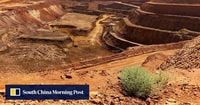On October 21, 2025, the global balance in the critical minerals market took a decisive turn. In Washington, D.C., under the watchful eyes of the world’s financial and political elite, the United States and Australia inked a landmark US$8.5 billion framework agreement targeting the supply of rare earth elements. These minerals, though obscure to most, are the backbone of modern technology—powering everything from smartphones and electric vehicles to advanced military hardware. The new pact, as reported by Bloomberg and the South China Morning Post, signals a major push by the West to loosen China’s formidable grip on these essential resources.
Rare earth elements have long been a quiet force in the global economy. According to Bloomberg, China has wielded these minerals as powerful trade leverage, shaping the fortunes of companies and even the diplomatic strategies of nations. The country dominates the mining, processing, and export of rare earths, controlling an estimated 60-70% of global supply. For years, this dominance has left other nations vulnerable to supply disruptions and price swings—sometimes at moments of high geopolitical tension.
The new US-Australia framework, formally titled the Framework for Securing of Supply in the Mining and Processing of Critical Minerals and Rare Earths, is designed to change that. Announced at a high-profile meeting in Washington, the agreement aims to “accelerate the secure supply of critical minerals and rare earths,” according to a White House statement. The deal isn’t just a handshake and a photo op; it comes with concrete commitments. Within six months, both countries will mobilize at least US$1 billion each in financing for projects expected to generate end products for buyers on both sides of the Pacific. The support will flow through a mix of loans, equity investments, and finalized offtake arrangements—industry speak for guaranteed purchase agreements that help new projects get off the ground.
It’s an ambitious plan, and not without its skeptics. Analysts cited by the South China Morning Post caution that building a truly secure, independent supply chain for rare earths is no overnight feat. “Developing a secure, independent supply chain may take the US 10 to 20 years,” industry experts warn. After all, rare earth extraction and processing are notoriously complex, environmentally sensitive, and capital-intensive. But the agreement is widely seen as a strong first step. Pini Althaus, CEO of US-based rare earth investor and developer Cove Capital, told the South China Morning Post, “Deals like this go a long way – this is a good start.”
Althaus also highlighted the strategic implications for China, suggesting that Beijing would likely grow “more concerned” as the deal matures and if the US signs similar pacts with other countries. The framework’s purchasing agreements and the introduction of “floor prices”—minimum guaranteed prices for minerals—are intended to make it harder for China to undercut competitors with rock-bottom rates. In effect, the US and Australia are betting that by locking in stable prices and guaranteed buyers, they can foster the long-term investments needed to challenge China’s dominance.
But why are these minerals so important? Rare earths, a group of 17 chemically similar elements, are essential for high-performance magnets in wind turbines, batteries in electric cars, and even guidance systems in missiles. Their unique properties make them irreplaceable in many modern technologies. Yet, the supply chain is fragile. Processing rare earths is a messy, expensive business, riddled with environmental and regulatory hurdles. That’s part of the reason why China’s dominance has persisted for decades: the country invested heavily in infrastructure and accepted the environmental costs that others shunned.
For the US and its allies, the risks of overreliance on a single supplier have become painfully clear. Past episodes—such as China’s temporary export restrictions during diplomatic disputes—have sent shockwaves through global manufacturing. In today’s world, where supply chain resilience has become a buzzword from boardrooms to government agencies, reducing dependence on Chinese minerals is seen as a matter of national security as much as economic necessity.
The new framework is also about more than just mining rocks. According to the White House, the agreement will give the US access to Australian critical minerals technology—a sector where Australia is seen as a global leader. This technology transfer could help American firms catch up in areas like efficient extraction, environmentally friendly processing, and advanced recycling. It’s a two-way street: Australian companies, in turn, will gain access to US capital and a guaranteed market for their products.
Of course, the deal’s impact won’t be felt overnight. As experts point out, it could take a decade or more before new mines, processing plants, and supply chains are fully operational. The initial US$2 billion in financing is only a down payment on the vast investments required. But the framework aims to send a clear message to investors, manufacturers, and governments: the era of complacency is over. The US and Australia are putting real money on the table to build a resilient, diversified supply of minerals that power the modern world.
Bloomberg’s reporting underscores how rare earths have become a new front in the broader contest between China and the West. As global demand for electric vehicles, renewable energy, and advanced electronics soars, control over these minerals is increasingly seen as a lever of economic and geopolitical power. For now, China remains the heavyweight. But with the US-Australia pact, the playing field may be starting to shift—if only a little.
Looking ahead, the success of the framework will hinge on execution. Will the promised financing materialize quickly? Can new projects overcome technical, environmental, and regulatory challenges? And will other countries—such as Canada, the European Union, or Japan—join similar initiatives to further dilute China’s influence? Pini Althaus, for one, believes the momentum is building. “If the US signs similar pacts with other countries, Beijing will likely grow more concerned,” he said, hinting at a future where rare earths are no longer a one-country show.
For now, the rare earths race is on. The US and Australia have laid down a marker, signaling their intent to reshape the global minerals market. The coming years will reveal whether this bold move can break China’s stranglehold—or if the world’s smartphones, cars, and clean energy dreams remain tethered to a single, distant supplier.




